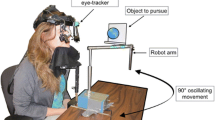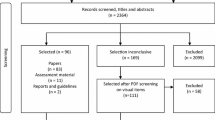Abstract
Visual pursuit is a key marker of residual consciousness in patients with disorders of consciousness (DOC). Currently, its assessment relies on subjective clinical decisions. In this study, we explore the variability of such clinical assessments, and present an easy-to-use device composed of cameras and video processing algorithms that could help the clinician to improve the detection of visual pursuit in a clinical context. Visual pursuit was assessed by an experienced research neuropsychologist on 31 patients with DOC and on 23 healthy subjects, while the device was used to simultaneously record videos of both one eye and the mirror. These videos were then scored by three researchers: the experienced research neuropsychologist who did the clinical assessment, another experienced research neuropsychologist, and a neurologist. For each video, a consensus was decided between the three persons, and used as the gold standard of the presence or absence of visual pursuit. Almost 10% of the patients were misclassified at the bedside according to their consensus. An automatic classifier analyzed eye and mirror trajectories, and was able to identify patients and healthy subjects with visual pursuit, in total agreement with the consensus on video. In conclusion, our device can be used easily in patients with DOC while respecting the current guidelines of visual pursuit assessment. Our results suggest that our material and our classification method can identify patients with visual pursuit, as well as the three researchers based on video recordings can.




Similar content being viewed by others
References
Laureys S, Celesia G, Cohadon F et al (2010) Unresponsive wakefulness syndrome: a new name for the vegetative state or apallic syndrome. BMC Med 8:68
Giacino JT, Ashwal S, Childs N et al (2002) The minimally conscious state: definition and diagnostic criteria. Neurology 58(3):349–353
Bruno M-A, Majerus S, Boly M et al (2012) Functional neuroanatomy underlying the clinical subcategorization of minimally conscious state patients. J Neurol 259:1087–1098
Boly M, Faymonville M-E, Peigneux P et al (2005) Cerebral processing of auditory and noxious stimuli in severely brain injured patients: differences between VS and MCS. Neuropsychol Rehabil 15(3–4):283–289
Giacino JT, Kalmar K, Whyte J (2004) The JFK coma recovery scale-revised: measurement characteristics and diagnostic utility. Arch Phys Med Rehabil 85:2020–2029
Seel RT, Sherer M, Whyte J et al (2010) Assessment scales for disorders of consciousness: evidence-based recommendations for clinical practice and research. Arch Phys Med Rehabil 91(12):1795–1813
Schnakers C, Vanhaudenhuyse A, Giacino J et al (2009) Diagnostic accuracy of the vegetative and minimally conscious state: clinical consensus versus standardized neurobehavioral assessment. BMC Neurol 9(1):35
Bagnato S, Boccagni C, Sant’Angelo A, Fingelkurts AAA, Fingelkurts AAA, Galardi G (2016) Longitudinal assessment of clinical signs of recovery in patients with unresponsive wakefulness syndrome after traumatic or nontraumatic brain injury. J Neurotrauma 33:1–5
Estraneo A, Moretta P, Cardinale V et al (2014) A multicentre study of intentional behavioural responses measured using the coma recovery scale-revised in patients with minimally conscious state. Clin Rehabil 29(8):803–808. doi:10.1177/0269215514556002
Thonnard M, Wannez S, Keen S et al (2014) Detection of visual pursuit in patients in minimally conscious state: a matter of stimuli and visual plane? Brain Inj 28(9):1164–1170
Vanhaudenhuyse A, Schnakers C, Brédart S, Laureys S (2008) Assessment of visual pursuit in post-comatose states: use a mirror. J Neurol Neurosurg Psychiatry 79(2):223
Cruse D, Fattizzo M, Owen AM, Fernández-Espejo D (2017) Why use a mirror to assess visual pursuit in prolonged disorders of consciousness? Evidence from healthy control participants. BMC Neurol 17(1):14. doi:10.1186/s12883-017-0798-1
Monti MM, Vanhaudenhuyse A, Coleman MR et al (2010) Willful modulation of brain activity in disorders of consciousness. N Engl J Med 362(7):579–589
Cruse D, Chennu S, Chatelle C et al (2012) Relationship between etiology and covert cognition in the minimally conscious state. Neurology 78:816–822. doi:10.1212/WNL.0b013e318249f6f0
Bekinschtein T, Coleman MR, Niklison J, Pickard JD, Manes FF (2008) Can electromyography objectively detect voluntary movement in disorders of consciousness? J Neurol Neurosurg Psychiatry 79:826–828
Stender J, Gosseries O, Bruno M-A et al (2014) Diagnostic precision of PET imaging and functional MRI in disorders of consciousness: a clinical validation study. Lancet 384(9942):514–522
Stender J, Kupers R, Rodell A et al (2014) Quantitative rates of brain glucose metabolism distinguish minimally conscious from vegetative state patients. J Cereb Blood Flow Metab 35:1–8. doi:10.1038/jcbfm.2014.169
Gosseries O, Thibaut A, Boly M, Rosanova M, Massimini M, Laureys S (2014) Assessing consciousness in coma and related states using transcranial magnetic stimulation combined with electroencephalography. Ann Fr Anesth Reanim. doi:10.1016/j.annfar.2013.11.002
Trojano L, Moretta P, Loreto V, Cozzolino A, Santoro L, Estraneo A (2012) Quantitative assessment of visual behavior in disorders of consciousness. J Neurol 259(9):1888–1895
Trojano L, Moretta P, Loreto V, Santoro L, Estraneo A (2013) Affective saliency modifies visual tracking behavior in disorders of consciousness: a quantitative analysis. J Neurol 260(1):306–308. doi:10.1007/s00415-012-6717-x
Hoyoux T, Wannez S, Langohr T, Wertz J, Laureys S, Verly J (2016) A new computer vision-based system to help clinicians objectively assess visual pursuit with the moving mirror stimulus for the diagnosis of minimally conscious state. In: IEEE Winter Conference on Applications of Computer Vision (WACV 2016)
Collobert R, Kavukcuoglu K, Farabet C (2011) Torch7: A matlab-like environment for machine learning. NIPS Work, BigLearn, pp 1–6
Landis JR, Koch GG (1977) The measurement of observer agreement for categorical data. Biometrics 33:159–174
Demertzi A, Ledoux D, Bruno M-A et al (2011) Attitudes towards end-of-life issues in disorders of consciousness: a European survey. J Neurol 258:1058–1065
Demertzi A, Schnakers C, Ledoux D et al (2009) Different beliefs about pain perception in the vegetative and minimally conscious states: a European survey of medical and paramedical professionals. Prog Brain Res 177:329–338
Bruno M-A, Ledoux D, Vanhaudenhuyse A, Gosseries O, Thibaut A, Laureys S (2011) Pronostic des patients récupérant du coma. In: Schnakers C, Laureys S (eds) Coma et États de Conscience Altérée. Springer, Paris, pp 17–30
Acknowledgements
The University and University Hospital of Liège, the French Speaking Community Concerted Research Action (ARC 12/17/01), the Belgian National Funds for Scientific Research (FRS-FNRS), Human Brain Project (EU-H2020-fetflagship-hbp-sga1-ga720270), and Luminous project (EU-H2020-fetopen-ga686764), the Wallonie-Bruxelles International, the James McDonnell Foundation, Mind Science Foundation, IAP research network P7/06 of the Belgian Government (Belgian Science Policy), the European Commission, the Public Utility Foundation ‘Université Européenne du Travail’, “Fondazione Europea di Ricerca Biomedica”, the Bial Foundation. OB and CM are research fellows, CC is post-doctoral fellow, and SL is research director at FRS-FNRS.
Author information
Authors and Affiliations
Corresponding author
Ethics declarations
Conflicts of interest
Phasya S.A. provided the device without any financial compensation.
Ethical approval
All procedures performed in studies involving human participants were in accordance with the ethical standards of the institutional and/or national research committee and with the 1964 Helsinki declaration and its later amendments or comparable ethical standards.
Informed consent
Informed consent was obtained from all individual participants included in the study, or by patient surrogate-decision makers.
Rights and permissions
About this article
Cite this article
Wannez, S., Hoyoux, T., Langohr, T. et al. Objective assessment of visual pursuit in patients with disorders of consciousness: an exploratory study. J Neurol 264, 928–937 (2017). https://doi.org/10.1007/s00415-017-8469-0
Received:
Revised:
Accepted:
Published:
Issue Date:
DOI: https://doi.org/10.1007/s00415-017-8469-0




